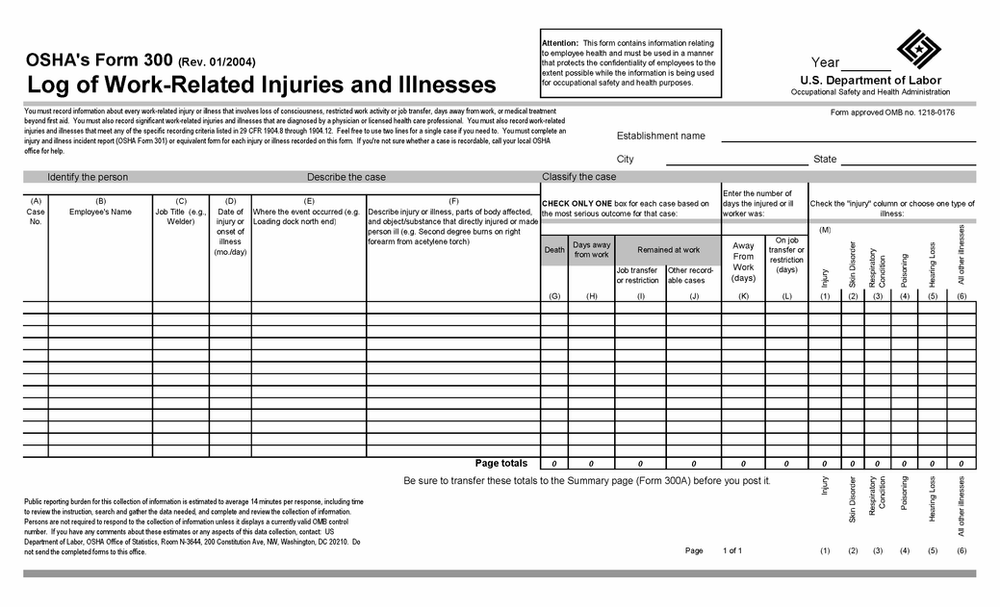It’s OSHA Reporting Season! Who Has To Report?
Each year OSHA requires a large number of companies to report documentation of any serious work-related injuries and illnesses. Companies should be sure they report if they are required to do so to ensure they are not given an OSHA citation or visit for lack of documentation. OSHA states that companies in particular industries with certain NAICS codes are not required to maintain and report OSHA injury and illness records. To search for your company’s NAICS code to know whether you are exempt or not, visit Non-Mandatory Appendix A to Subpart B — Partially Exempt Industries.
Employers should also keep in mind that if they are required to report OSHA 300 logs they are also required to report any worker fatality within 8 hours of an incident and any amputation, loss of an eye or hospitalization within 24 hours of an incident. While minor first aid injuries do not have to be reported to OSHA, it can be very beneficial to the company to track any type of incident, no matter the severity. Understanding what is causing incidents can help companies better train employees in best practices and hazard awareness as well as prevention. When employees are cognizant of the hazards around them and how to prevent injury, they begin to work safer, which reduces injury rates and worker compensation costs.
Reporting Process
The OSHA reporting processes are meticulous and one wrong move can result in a fine or visit from OSHA, even years after filing. Keep in mind for employers required to submit an OSHA 300 log, logs must be formulated, signed by an executive within the organization and submitted to OSHA by March 2, 2020. Employers must additionally post the signed OSHA logs in an area accessible to all employees between February and April so that they have access to incident records. If a company has multiple locations they must do this at each facility with the corresponding OSHA log. Companies are required to maintain documents for up to 5 years, but maintaining records for all previous years can be extremely useful for data analysis and tracking company progress.

Employers who are required to report OSHA 300 logs should ensure they fill out the forms with accurate information, as using the wrong data can also get them put on the list for an OSHA visit. This includes verifying you are reporting hours for not only field labor employees, but also all office personnel and temporary workers. Many companies overlook including temporary workers in hour, employee and incident counts, but they must remember that both the staffing agency and company are jointly responsible for temporary employee safety. For more information on OSHA’s regulations regarding temporary workers, read Protecting Temporary Workers.
For information on how to report and where to report OSHA logs, check out Reduce Anxiety Filing OSHA 300A Reports.
At SMART Safety we understand how difficult it can be to keep up with safety training, reporting, documentation and analysis, which is why we offer our Safety Program Management services. Our SMART Safety safety program customers have access to a safety services manager 24/7, 365 days a year and have SMART Safety to rely on for OSHA compliance, reporting and defense. We can relieve the stresses of OSHA reporting for our customers by maintaining adequate incident logs we use to create and submit OSHA 300 forms. We also track and conduct safety training, audits and meetings to better understand how to improve workplace safety and reduce incidents.
SMART Safety customers may rest assured knowing that SMART Safety can handle their OSHA log creation and reporting. If you are a SMART Safety customer with questions regarding your company’s OSHA logs or reporting processes, please give a call to your account manager or any of our safety services managers who will be happy to assist you.
For more information on how SMART Safety can help assist your company with safety program management, visit Contact Info or give us a call at (844) 820-8098.
More than just safety consultants, SMART Safety is an integrated safety services system.
#WorkplaceSafety #OSHAReporting #OSHA300 #SafetyFirst








